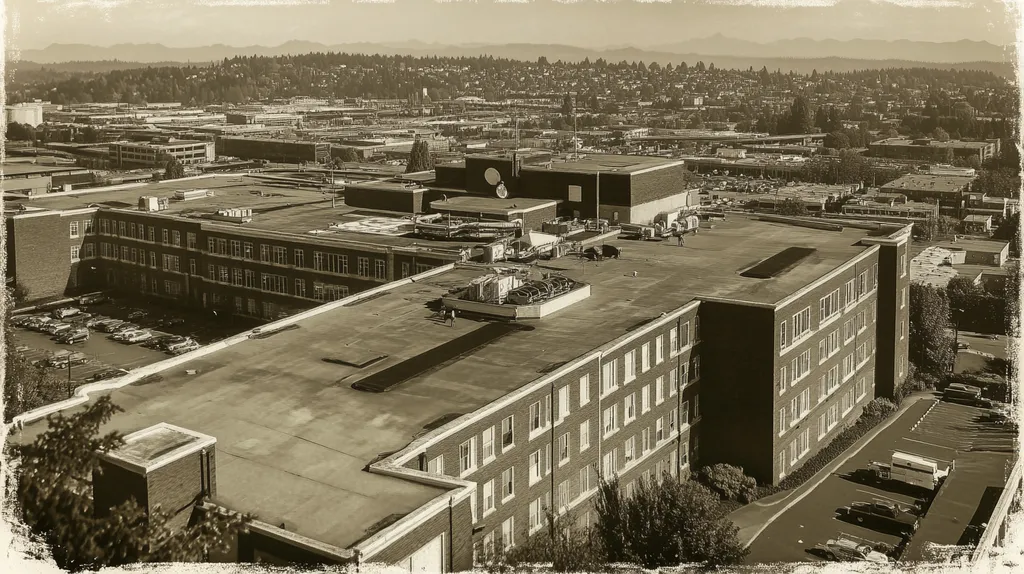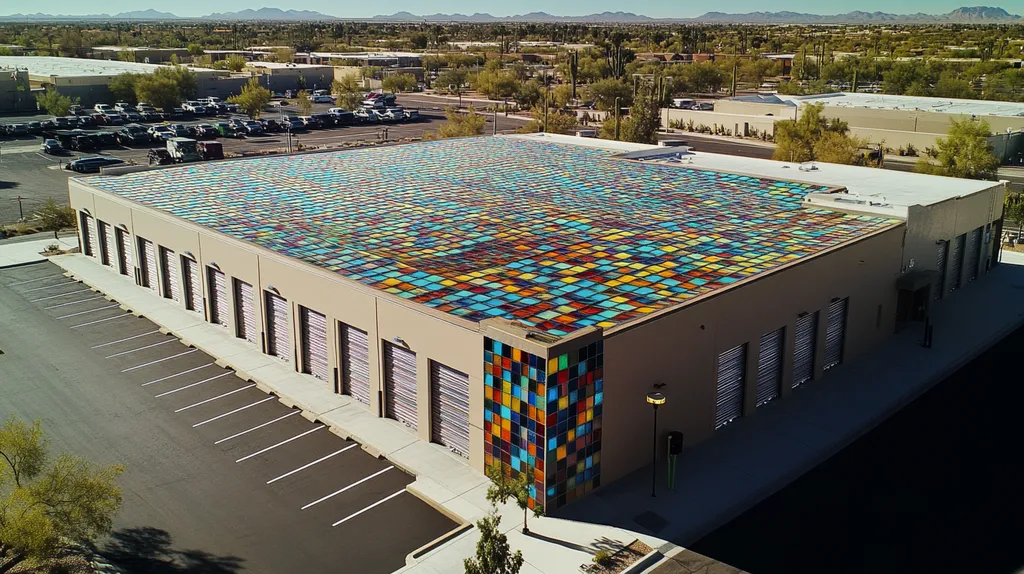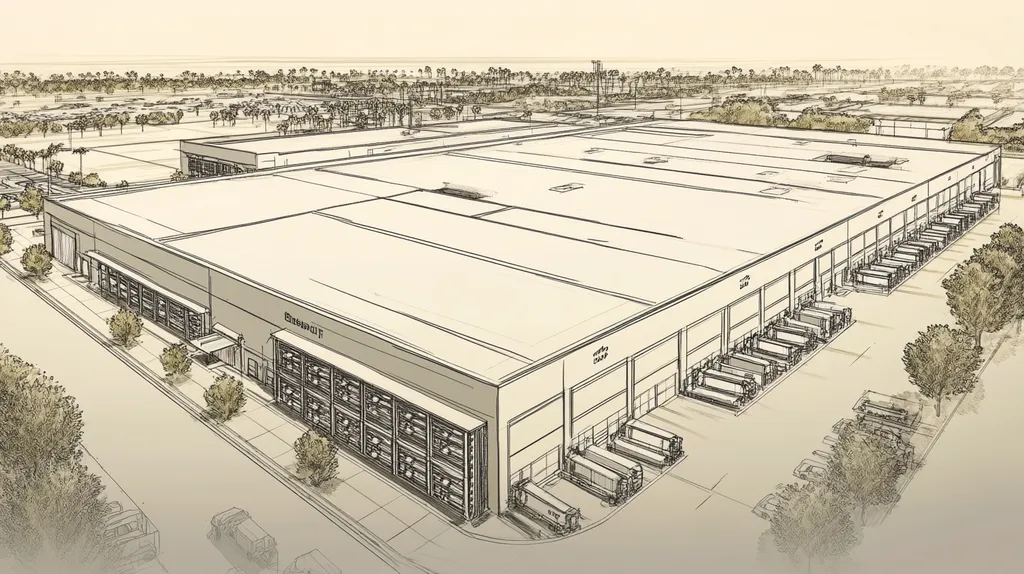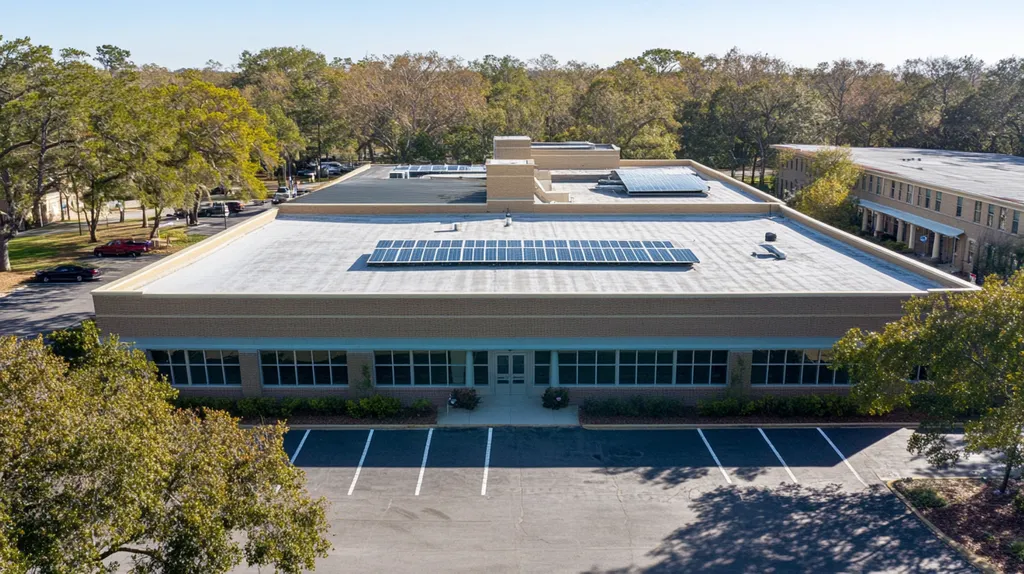With over 11 million tons of roofing waste entering landfills annually, the commercial roofing industry faces mounting pressure to adopt sustainable practices. The environmental and economic costs of this waste are staggering, yet many facility managers lack clear guidance on implementing effective recycling programs.
This comprehensive handbook addresses this critical gap by examining the fundamental concepts, system components, and practical implementation methods for roof recycling initiatives. Through detailed analysis of materials, processes, and performance metrics, facility managers can develop robust recycling strategies that benefit both their operations and the environment.
From identifying valuable metals to optimizing disposal techniques, each section provides actionable insights for transforming roofing waste into valuable resources.
SECTION 1: FUNDAMENTAL CONCEPTS
As concerns about environmental sustainability become more pressing, facility managers find themselves under increasing pressure to adopt green practices. Roofing materials contribute significantly to landfill waste, with the Environmental Protection Agency highlighting the scale of this issue. By improving roof recycling initiatives, facility managers can make a substantial positive impact—not only benefiting the environment but also enhancing their facility’s reputation and operational efficiency. This section delves into the types of recyclable roofing materials, the significant environmental perks of recycling, and the regulatory guidelines that shape roofing waste management.
Types of Recyclable Roofing Materials
Roofing materials vary widely, and understanding their recycling potential is essential. Asphalt shingles, for instance, are a staple in roofing construction and can be recycled into new shingles or even repurposed for roadways. This means that removing an old roof can actually contribute materials for new construction projects.
Similarly, metal roofing is highly recyclable and can be melted down to create new metal products. Rubber roofing systems, which are made from recycled tires, are also gaining traction, with programs designed to effectively repurpose this material to limit waste.
Single-ply membranes, commonly composed of TPO and PVC, can often be transported to specialized facilities for recycling. For instance, PVC roofing membranes can be reprocessed without losing their vital physical properties, making them a practical choice. By choosing recyclable materials, facility managers not only reduce waste but also support the creation of a circular economy.
Utilizing these recyclable options can lead to long-term cost savings while also establishing a positive environmental legacy for the organization.
Environmental Benefits of Roof Recycling
The benefits of roof recycling extend beyond waste reduction; they touch on critical environmental concerns. Recycling roofing materials can markedly lessen the volume of waste sent to landfills, which in turn reduces harmful greenhouse gas emissions.
Moreover, the recycling process conserves vital natural resources and decreases the demand for raw materials. This reduction leads to a lower energy consumption during manufacturing and transportation, further reducing carbon footprints from roofing projects.
Recycling not only benefits the immediate environment but also bolsters urban sustainability. By supporting local markets for recycled materials, facility managers play a part in strengthening local economies, which fosters healthier communities. This support can lead to long-lasting and meaningful economic benefits.
In conclusion, enhancing roof recycling strategies enables facility managers to align their operational practices with broader sustainability aims, improving their corporate responsibility and enhancing their public image.
Regulatory Framework for Roofing Waste
Navigating the regulatory landscape surrounding roofing waste is essential for facility managers aiming for compliant recycling practices. Many states have enacted laws mandating the recycling of construction and demolition debris, including roofing materials. Familiarity with these regulations is critical in avoiding penalties and ensuring proper disposal of waste.
Compliance not only reflects a commitment to sustainable practices but also contributes positively to a company’s brand equity. Engaging in recycling showcases a proactive approach to environmental responsibility, setting an example for other industries.
Furthermore, various initiatives and incentives exist to promote recycling, such as grant programs designed to encourage sustainable building practices. These incentives can significantly lower upfront costs, making the transition to sustainable practices more feasible.
By adeptly navigating this regulatory framework, facility managers can develop strong recycling programs that adhere to legal standards and elevate industry practices. This proactive stance can pave the way for innovative, sustainable roofing solutions that benefit both businesses and communities.
SECTION 2: SYSTEM COMPONENTS
With the urgency for sustainability rising, facility managers face the challenge of tackling the 70 million tons of roofing waste that end up in landfills each year. Understanding the components that make up roofing materials is crucial to promoting responsible recycling initiatives. By focusing on identifying valuable metals, assessing the role of non-metallic materials, and recognizing hazardous substances in older roofs, facility managers can take significant steps toward effective recycling practices. This section explores these critical elements of roofing systems to deepen recycling efforts.
Identifying Valuable Metals in Roofing
Valuable metals, such as copper, aluminum, and steel, are commonly found in roofing systems. Recognizing these materials is essential for boosting recycling efforts. Copper, particularly, is a highly sought-after commodity, often fetching high prices in the recycling market, thereby encouraging facility managers to extract it during roof renovations.
Aluminum is another important metal, frequently used in roofing flashing and edge details. Its lightweight nature and resistance to corrosion further enhance its appeal as a recyclable material. By inventorying metal components, managers can create effective plans for recovery.
Steel structures are also recyclable, potentially leading to significant cost savings. Implementing a metal recovery plan during roof replacement projects can minimize waste and promote sustainability.
Collaborating with certified recycling companies ensures that extracted metals are processed efficiently, maximizing their economic value. This strategic approach conserves resources while bolstering environmental goals.
Non-Metallic Materials in Roofing Systems
Non-metallic materials, such as rubber and plastic membranes, play a vital role within roofing systems and present unique recycling challenges due to their complex compositions. However, advancements in recycling technologies offer promising opportunities for material recovery.
For instance, thermoplastic membranes can often be repurposed and reprocessed into new roofing products, significantly reducing landfill contributions. Facility managers who implement targeted collection and recycling strategies can divert substantial volumes of these materials from disposal.
Moreover, supporting manufacturers that utilize recycled components helps foster circular economy initiatives. By choosing products made from recycled materials, facility managers can actively encourage demand for recycling-friendly options.
Ongoing training and awareness sessions regarding non-metallic materials can empower facility managers to make informed decisions about their roofing systems. Every effort toward recycling contributes to a broader movement toward sustainability.
Hazardous Materials in Older Roofs
Older roofs may harbor hazardous materials, like asbestos or lead-based coatings, which present serious risks during demolition or repair. It is critical to identify these hazardous materials to ensure safety and compliance with environmental regulations.
Asbestos, often found in aging roofing systems, requires specialized handling and disposal techniques. Facility managers should conduct thorough inspections and collaborate with licensed abatement contractors when necessary to manage these risks effectively.
Lead paint present on roofs can also pose significant health hazards. Instituting testing protocols prior to renovation helps identify potential risks, informing safe management practices. Addressing hazardous materials properly not only ensures compliance but also protects personnel and the environment.
Furthermore, educating staff about the dangers associated with these materials can bolster safety measures. By taking proactive steps, facility managers can mitigate risks, promote a safer work environment, and improve recycling outcomes.
SECTION 3: IMPLEMENTATION METHODS
As the urgency for sustainable roofing practices intensifies, facility managers have a critical role in shifting the narrative of roofing waste. Alarmingly, nearly 14 million tons of roofing waste are sent to landfills every year, which not only contributes to environmental degradation but also elevates operational costs and reduces corporate accountability. To effect meaningful change, organizations must prioritize safe disposal, effective on-site preparation, and finding reliable recycling centers. Emphasizing these strategies ensures that recycling initiatives are both impactful and actionable.
Safe Disposal and Sorting Practices
Adopting safe disposal and sorting practices is essential for any successful roof recycling program. Properly separating waste materials minimizes contamination and significantly increases the percentage of materials that can be recycled. For instance, keeping TPO and PVC membranes distinct from metal flashings facilitates higher recycling rates.
Additionally, clearly labeling disposal bins can streamline the sorting process. When team members know which materials belong where, the chances of contamination drop. This not only boosts recycling efforts but also helps ensure compliance with local regulations.
Frequent training sessions focused on disposal practices can empower all staff to engage in recycling initiatives. An informed workforce that understands the importance of sorted disposal can dramatically enhance a facility’s overall recycling efficiency.
Lastly, conducting regular audits of disposal practices can highlight areas needing improvement. By consistently evaluating waste streams, facility managers can refine their strategies to achieve substantial waste reduction.
On-Site Preparation and Storage Techniques
Effective on-site preparation lays the foundation for robust recycling efforts, beginning the moment materials are removed from the roof. Key preparation steps include cleaning and cutting materials to manageable sizes, which can lower transportation costs and improve handling for recycling centers.
Establishing a dedicated staging area for sorted materials greatly enhances organization on-site. This area should be easily accessible and clearly labeled for different waste categories. Implementing a color-coded system can further aid workers in quickly identifying storage requirements for each type of material.
Handling materials while they are wet is a critical concern. Ensuring stored materials are dry not only prevents additional contamination but also enhances their recycling potential. Utilizing tarps or stored materials under cover will protect them from the elements.
Finally, partnering with contractors who are versed in these preparation techniques can significantly improve the efficiency of recycling operations. Experienced professionals provide invaluable support that smooths the overall process.
Finding Reliable Recycling Centers
Identifying reliable recycling centers is fundamental for successful roof recycling initiatives. Not all facilities accept the same types of materials, making it essential to research local centers that specialize in roofing material recycling.
Networking with fellow facility managers can yield valuable insights and recommendations. Many professionals share information about dependable recycling partners during industry events. Such interactions can reveal hidden resources that enhance recycling practices.
Moreover, fostering relationships with recycling centers can lead to improved service and potentially reduced costs. Understanding a center’s specific material requirements helps streamline the recycling process.
Lastly, pay attention to certifications when selecting a recycling center. Facilities certified by relevant authorities are more likely to adhere to industry standards, ensuring responsible and effective recycling operations.
SECTION 4: MAINTENANCE REQUIREMENTS
Effective roof recycling initiatives begin long before the actual removal of roofing materials. Without proper pre-removal inspections, critical materials may be overlooked, leading to significant resource waste and increased landfill contributions. Property owners and facility managers must prioritize thorough planning to optimize recycling potential. This section highlights essential maintenance requirements that can dramatically enhance the success of recycling efforts.
Pre-Removal Inspections and Planning
Conducting pre-removal inspections is vital for identifying the roofing materials in place. This assessment not only evaluates the current roofing system but also helps determine which materials can be recycled effectively. Facility managers should engage qualified professionals for these assessments, including structural evaluations and the identification of any hazardous materials.
Proper planning is crucial and should outline a clear recycling strategy before any materials are removed. Establishing achievable goals based on identified materials and understanding local recycling regulations will foster compliance and successful recovery outcomes. Documenting these plans strengthens accountability and can greatly enhance recycling efforts.
Inadequate planning can lead to unforeseen challenges, jeopardizing recycling initiatives. By addressing logistics, such as waste management processes and transportation needs in advance, facility managers can streamline efforts and maximize the percentage of materials diverted from landfills.
Additionally, having a contingency plan ready to address potential issues that may arise during the removal process is advantageous. This foresight enables adjustments while upholding recycling objectives.
Separation and Cleaning of Materials
After the roof has been removed, separating and cleaning recyclable materials is paramount. Materials like metal, shingles, and insulation must be sorted according to specific recycling requirements. This meticulous process minimizes contamination, which is essential for successful recycling.
Creating dedicated areas for sorting materials can improve efficiency and accuracy. Facility managers should consider implementing clearly labeled bins or sections for different types of materials to prevent mixing and confusion. This organization enhances recycling rates and simplifies the process for contractors and workers alike.
Cleaning materials of non-recyclable contaminants is also critical. Adhesives, roofing underlayment, and insulation fragments can compromise the integrity of recyclable materials. Investing in proper training and procedures for cleaning can elevate the quality of the recycled output.
Collaboration with recycling facilities offers valuable insights into material specifications. Understanding the requirements of recyclers ensures effective preparation of materials for processing, further maximizing recovery rates.
Training for Roofing Contractors
Investing in training for roofing contractors is essential to the success of recycling initiatives. Contractors need to be educated about the importance of recycling and the specific protocols required during the roof removal and replacement process. Training ensures they understand how to effectively separate and clean materials.
Ongoing education will further enhance contractor skills and keep them abreast of the latest recycling technologies and methods. This approach can lead to improved efficiency and greater compliance with local and federal recycling regulations.
Cultivating a culture of sustainability among contractors can significantly enhance recycling outcomes. When workers feel motivated and understand their contributions to a larger environmental effort, they are more likely to adhere to recycling practices.
Employers should also implement accountability measures to maintain high standards in recycling practices. Encouraging feedback from contractors fosters a spirit of collaboration, helping to identify problems and develop effective solutions that ultimately contribute to the success of roofing projects.
SECTION 5: PERFORMANCE METRICS
Measuring the success of roof recycling initiatives is essential for facility managers committed to sustainability. With more than 11 million tons of roofing material ending up in landfills each year, the stakes are high. Implementing effective performance metrics allows property owners to assess the efficiency and impact of their recycling efforts, ensuring they contribute positively to both the environment and their financial health. This section outlines key metrics that can guide these initiatives effectively.
Measuring Recycling Efficiency and Yield
Establishing a clear system for measuring recycling efficiency is vital for any successful roofing project. Efficiency can be assessed by tracking the ratio of materials that get recycled versus those that are discarded. For example, if a facility manages to recycle 75% of its roofing materials, it showcases impressive waste management practices.
Yield refers to the total amount of reusable material recovered during the recycling process. Quantifying yield aids property owners in understanding the tangible benefits of their recycling initiatives. For instance, if a project recovers 3,000 pounds of shingles, that represents valuable material that can be repurposed into new products, reinforcing the initiative’s worth.
Performing regular audits provides ongoing insights into these critical metrics. Such assessments enable facility managers to pinpoint areas for improvement, driving more effective recycling practices over time. Furthermore, presenting these metrics to stakeholders can enhance support for future recycling initiatives.
In summary, understanding and measuring both efficiency and yield equips facility managers with actionable data, promoting sustainable practices throughout the roofing industry.
Tracking Environmental Impact Reduction
Quantifying the environmental impact of recycling adds accountability and motivation for facility managers. One effective approach is employing a Life Cycle Assessment (LCA), which evaluates the environmental effects across all stages of a roofing product’s life.
By using LCA, facility managers can quantify reductions in greenhouse gas emissions, energy consumption, and raw material usage resulting from their recycling efforts. For example, recycling asphalt shingles can save an estimated 1.3 billion gallons of liquid asphalt each year, significantly cutting down on resource demands in manufacturing.
Tracking these metrics also helps organizations meet increasing regulatory demands and sustainability goals. As both consumers and clients grow more environmentally conscious, demonstrating a commitment to reducing environmental footprints can greatly enhance a facility’s reputation.
Establishing clear benchmarks for impact reduction facilitates continuous improvement. Facility managers who can showcase measurable environmental benefits become stronger advocates for expanding recycling initiatives within their organizations.
Cost-Benefit Analysis of Recycling Initiatives
A thorough cost-benefit analysis is crucial for facility managers considering the implementation of roof recycling. While initial recycling costs may seem higher, the long-term savings typically outweigh these expenses. For instance, recycling efforts can significantly lower landfill disposal fees, which often range from $50 to $100 per ton.
Apart from cost savings, property owners can explore potential revenue opportunities from recycled materials. For instance, materials retrieved from old roofs can be sold to manufacturers, thus generating a new revenue stream. Understanding these financial dynamics enables organizations to make informed decisions regarding their recycling strategies.
Moreover, incorporating recycling into roofing projects can yield tax credits and green building certifications. These financial incentives enhance the facility’s overall return on investment, making recycling not just an environmental choice but also a savvy economic decision.
Regularly updating the cost-benefit analysis ensures facility managers stay informed about the evolving financial landscape connected to their recycling efforts. By strategically aligning costs with environmental benefits, organizations can achieve meaningful impact while fostering a culture of sustainability.
SECTION 5: PERFORMANCE METRICS
Measuring the success of roof recycling initiatives is vital for facility managers committed to promoting sustainability. With over 11 million tons of roofing material ending up in landfills each year, the urgency for effective strategies has never been greater. By implementing robust performance metrics, property owners can effectively assess the efficiency and environmental impact of their recycling efforts, ensuring they positively influence both ecological health and financial stability. This section explores key metrics that can guide these initiatives toward success.
Measuring Recycling Efficiency and Yield
Establishing a system to measure recycling efficiency is non-negotiable for any roofing project. Efficiency can be gauged by tracking the percentage of materials that are successfully recycled versus those that are discarded. For instance, if a facility achieves a 75% recycling rate for its roofing materials, it demonstrates commendable waste management practices that minimize landfill use.
Yield refers to the total amount of reusable material recovered during the recycling process. Quantifying yield empowers property owners to grasp the benefits of their recycling initiatives more clearly. For example, recovering 3,000 pounds of shingles indicates significant quantities of material that can be remanufactured, reinforcing the value of the initiative.
Regular audits provide ongoing insights into these critical metrics. Through these assessments, facility managers can pinpoint areas for improvement, thereby fostering increasingly effective recycling practices. Additionally, presenting these metrics to stakeholders can enhance support for future recycling efforts.
Ultimately, understanding and measuring both efficiency and yield equips facility managers with actionable data, supporting the movement toward sustainable practices throughout the roofing industry.
Tracking Environmental Impact Reduction
Quantifying the environmental impact of recycling initiatives enhances accountability and motivation for facility managers. One effective strategy is to employ a Life Cycle Assessment (LCA), which provides a comprehensive evaluation of the environmental effects throughout a roofing product’s lifecycle.
Utilizing LCA enables facility managers to quantify reductions in greenhouse gas emissions, energy consumption, and raw material usage stemming from their recycling efforts. For instance, recycling asphalt shingles can save an astounding estimated 1.3 billion gallons of liquid asphalt annually, significantly lessening reliance on vital resources during manufacturing.
Tracking these environmental metrics not only helps organizations meet evolving regulatory requirements but also aligns with increasing sustainability goals. As consumers and clients prioritize environmental responsibility, showcasing a commitment to reducing ecological footprints can greatly enhance a facility’s market reputation.
Setting clear benchmarks for impact reduction supports ongoing improvement. Facility managers who can consistently demonstrate environmental benefits can become influential advocates for expanded recycling initiatives within their organizations.
Cost-Benefit Analysis of Recycling Initiatives
A comprehensive cost-benefit analysis is essential for facility managers examining roof recycling. Although the initial costs may seem daunting, the long-term financial benefits often far outweigh these investments. For example, recycling efforts can notably reduce landfill disposal fees, which typically range from $50 to $100 per ton.
Beyond cost savings, property owners can unlock potential revenue streams from the sale of recycled materials. Materials recovered from old roofs can be sold to manufacturers, creating an additional income source. Understanding these financial dynamics empowers organizations to make informed decisions about their recycling strategies.
Moreover, incorporating recycling into roofing projects can yield tax credits and green building certifications. These incentives can significantly boost a facility’s overall return on investment, making recycling an astute economic choice as well as an environmentally conscious one.
Regularly updating the cost-benefit analysis ensures facility managers remain informed about the evolving financial landscape surrounding recycling. By strategically aligning costs with environmental benefits, facilities can make a meaningful impact while fostering an enduring culture of sustainability.
Looking Ahead
With roofing waste contributing over 11 million tons to landfills annually, the environmental and economic imperative for improved recycling practices has never been clearer.
By implementing comprehensive recycling programs built on proper planning, efficient sorting, and reliable partnerships with recycling centers, facility managers can dramatically reduce their environmental impact while potentially generating new revenue streams.
The tools, technologies, and infrastructure needed to transform roofing waste into valuable resources already exist – what’s required now is widespread adoption of these proven practices.
Through continued innovation in recycling methods, strengthened industry partnerships, and enhanced training programs, the commercial roofing sector can lead the construction industry toward a more sustainable future while delivering measurable benefits to both facilities and communities.
FREQUENTLY ASKED QUESTIONS
Q. What are the types of recyclable materials in a commercial roof?
A. Common recyclable materials include asphalt shingles, metal roofing, and rubber membranes. Understanding these can significantly enhance your recycling efforts and reduce waste. By using recyclable products, you contribute to a circular economy while minimizing environmental impact.
Q. How can I identify valuable metals in an industrial roof?
A. Valuable metals like copper, aluminum, and steel are often found in roofing systems. Recognizing these materials ensures maximized recycling efforts and cost savings. Extracting metals enhances your recycling initiatives while conserving resources, supporting sustainability in your operations.
Q. What are the best practices for safe disposal of industrial roofing materials?
A. Implementing safe disposal involves sorting materials correctly and minimizing contamination. Clearly labeling bins and providing staff training can improve recycling effectiveness. Establishing organized waste management protocols will lead to successful recovery and a cleaner environment.
Q. Why are pre-removal inspections important for commercial roofs?
A. Pre-removal inspections identify recyclable materials and hazardous substances. Proper assessments and planning ensure efficient recycling and compliance with regulations. Thorough evaluations maximize the potential for resource recovery, benefiting both the environment and your facility.
Q. How can performance metrics improve roof recycling initiatives?
A. Metrics track recycling efficiency and yield, helping identify areas for improvement. Regularly measuring these metrics will enhance the success of your initiatives and contribute positively to environmental goals. Clear data supports informed decision-making and encourages accountability.
Q. What role do hazardous materials play in older industrial roofs?
A. Older roofs may contain harmful substances like asbestos or lead, requiring special handling. Identifying these materials ensures compliance with regulations and enhances safety measures. Regular inspections and proper training mitigate risks associated with hazardous materials during recycling processes.
Q. How can facility managers find reliable recycling centers for roofing materials?
A. Research local centers that specialize in recycling roofing materials for effective disposal. Networking with other facility managers can provide valuable recommendations. Building relationships with dependable recycling partners can enhance both service quality and operational efficiency.










